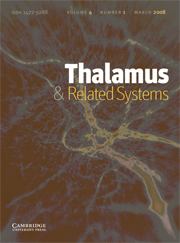Article contents
Surgical control of the human thalamocortical dysrhythmia: II. Pallidothalamic tractotomy in Parkinson's disease
Published online by Cambridge University Press: 12 April 2006
Abstract
Following earlier stereotactic experiences, we re-explored the possibilities of a therapeutic lesion of the pallidothalamic tract in the fields H1 and H2 of Forel in patients with parkinsonian signs. The physiopathological rationale of the pallidothalamic tractotomy (PTT) is based on the presence in the parkinsonian brain of a state of thalamic overinhibition due to an increased output of the internal pallidum. This causes the development of a thalamocortical dysrhythmia characterized by increased low frequencies in the relevant thalamic and frontal cortical areas. The fields of Forel are strategically placed to control this thalamic overinhibition, as they give passage to the majority of the pallidothalamic fibres. Magnetic resonance- and microelectrode-guided stereotactic PTT was proposed to 21 parkinsonian patients (mean age: 60 ± 10 years; mean Hoehn and Yahr in on-condition: 3.5 ± 1; mean disease duration: 11 ± 5 years). At a follow-up of 14 ± 6 months and in on-medication condition, a significant (P < 0.001) postoperative improvement of the motor part of the UPDRS (64.6%) and of the activities of daily living (ADL; 75.8%) was observed. Rest tremor, on-chorea and rigidity were reduced by 77.9, 92.2 and 82.3%, respectively. Distal and axial hypobradykinesias showed an improvement of 72.9 and 64%, respectively. Gait and postural stability also improved (57.5 and 66%, respectively) but at a lower level of significance (P < 0.005). Voice was not statistically influenced. L-dopa intake was decreased by 52.2% (P < 0.001) and 33% of the patients could be freed from treatment. In conclusion, PTT is an effective treatment for chronic therapy-resistant Parkinson's disease, improving symptoms in both on- and off-conditions.
- Type
- Research Article
- Information
- Copyright
- 2001 Elsevier Science Ltd
- 9
- Cited by


